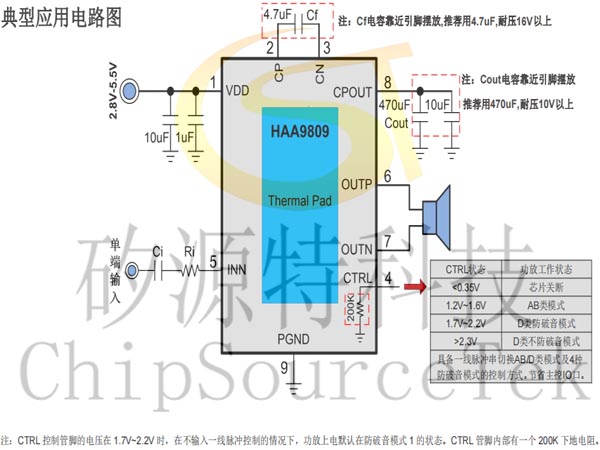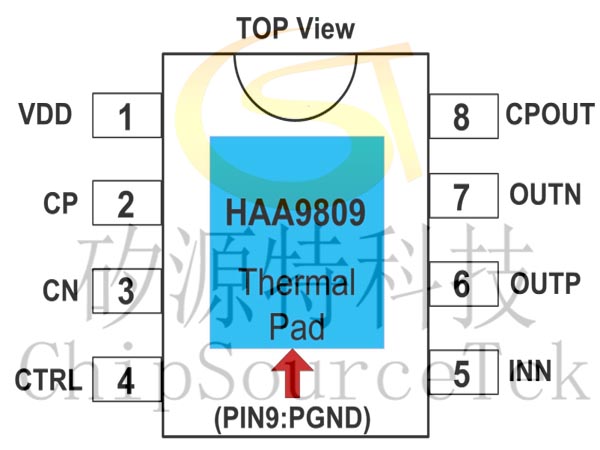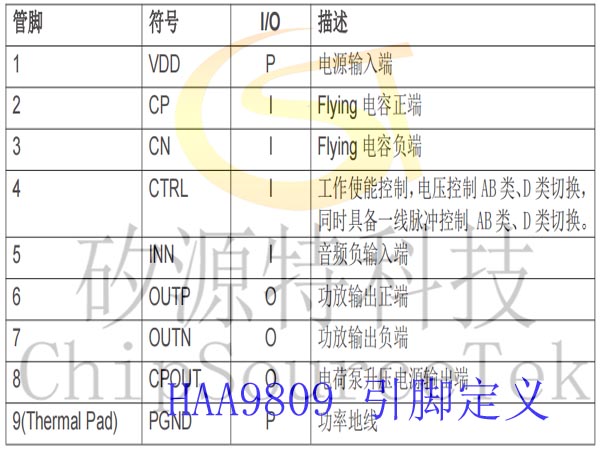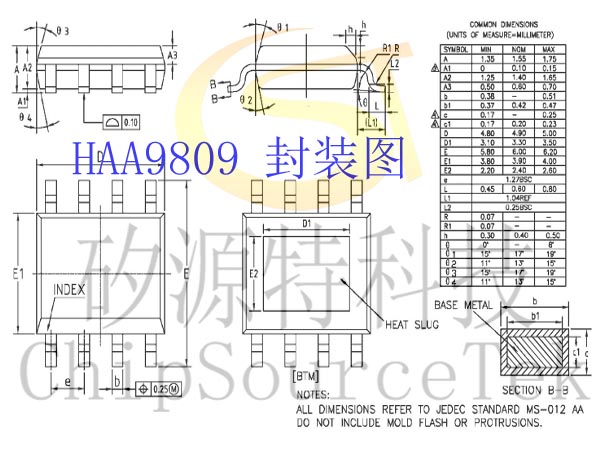Products
Products
HAA9809
HAA9809 Adaptive charge pump boost Adaptive charge pump boost,4 kinds of anti-breaking sound optional, Class AB/Class D switching,5.4W mono audio amplifier.
The HAA9809 is a capacitive boost, crack-proof, Class AB/D switchable mono audio amplifier that provides up to 5.4W continuous output power for 4Ω loads.
HAA9809's unique single-ended input architecture and extremely high PSRR effectively improve the HAA9809's ability to suppress RF noise.
The HAA9809 is available in an ESOP8L package.
The HAA9809 is a capacitive boost, crack-proof, Class AB/D switchable mono audio amplifier that provides up to 5.4W continuous output power for 4Ω loads.
HAA9809's unique single-ended input architecture and extremely high PSRR effectively improve the HAA9809's ability to suppress RF noise.
The HAA9809 is available in an ESOP8L package.
HAA9809 Description:
HAA9809 Adaptive charge pump boost Adaptive charge pump boost,4 kinds of anti-crack optional, Class AB/Class D switching,5.4W mono audio power amplifier
The HAA9809 is a capacitive boost, crack-proof, Class AB/D switchable mono audio power amplifier that provides up to 5.4W continuous output power for 4Ω loads.
HAA9809 built-in unique anti-crack function, can automatically adjust the power amplifier gain according to the size of the output signal, prevent the output clipping distortion, to achieve a more comfortable hearing experience, HAA9809 also has a dynamic boost function, when the input signal is very small charge pump does not boost the voltage, for the through mode to reduce power consumption and improve efficiency; Charge pump boost is started when the input signal is large and a larger dynamic range is needed to achieve a perfect balance between efficiency and output power.
HAA9809's unique single-ended input architecture and extremely high PSRR effectively improve the HAA9809's ability to suppress RF noise. The HAA9809 has a very low turn-off current, greatly extending the standby time of the system. The OCP, OTP, and UVLO protection functions enhance system reliability. Turning POP-click suppression on and off improves the auditory perception of the system and simplifies system debugging.
The HAA9809 is available in an ESOP8L package with heat sink
The HAA9809 is a capacitive boost, crack-proof, Class AB/D switchable mono audio power amplifier that provides up to 5.4W continuous output power for 4Ω loads.
HAA9809 built-in unique anti-crack function, can automatically adjust the power amplifier gain according to the size of the output signal, prevent the output clipping distortion, to achieve a more comfortable hearing experience, HAA9809 also has a dynamic boost function, when the input signal is very small charge pump does not boost the voltage, for the through mode to reduce power consumption and improve efficiency; Charge pump boost is started when the input signal is large and a larger dynamic range is needed to achieve a perfect balance between efficiency and output power.
HAA9809's unique single-ended input architecture and extremely high PSRR effectively improve the HAA9809's ability to suppress RF noise. The HAA9809 has a very low turn-off current, greatly extending the standby time of the system. The OCP, OTP, and UVLO protection functions enhance system reliability. Turning POP-click suppression on and off improves the auditory perception of the system and simplifies system debugging.
The HAA9809 is available in an ESOP8L package with heat sink
4 kinds of anti-crack sound can be selected
Adaptive boost function, Charge_pump boost to 6.6V
Class D output power:
Adaptive boost function, Charge_pump boost to 6.6V
Class D output power:
-5. 4 W (VDD=4.5V, RL =4Ω,NCN OFF THD+N=10%)
-5. 2 W (VDD=4.2V, RL =4Ω,NCN OFF THD+N=10%)
Class AB output power:
2W (VDD=4.2V, RL =4Ω, booster off THD+N=10%)
Operating voltage: 2.8V to 5.5V
Low distortion and noise
Enable or disable the POP-click suppression function
Turn-off current (<1uA)
OCP, OTP, and UVLO protection functions
The HAA9809 is available in an ESOP8L package with heat sink
Low distortion and noise
Enable or disable the POP-click suppression function
Turn-off current (<1uA)
OCP, OTP, and UVLO protection functions
The HAA9809 is available in an ESOP8L package with heat sink
Part number (P/N) | encapsulation | Surface printing | package |
ESOP8L | XXXXXXXX | 4000 PCS/roll |
HAA9809 Typical application circuit diagram:








